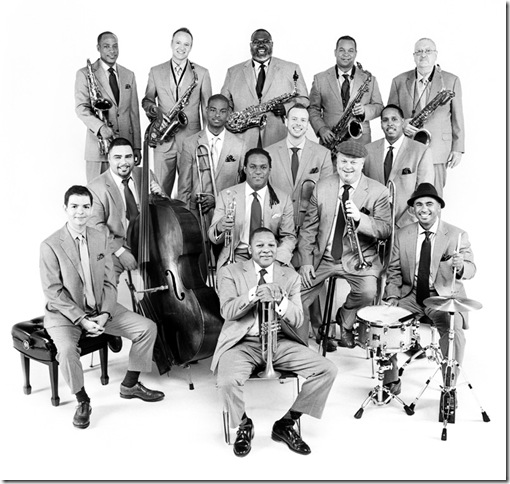When you think about it, the Jazz at Lincoln Center Orchestra is essentially the only ensemble in the entire country quite like it, a group whose purpose is to keep a flame for the benefit of the American people and occasionally stoke it with fresh wood.
There are many hundreds of university-based jazz bands, and most of the major symphonic orchestras do plenty of outreach at home and on the road. But the colleges focus primarily on educating their students, and the orchestras have a corpus of music that endures even when educational programs are meager.
The Jazz at Lincoln Center Orchestra, on the other hand, exists to remind us every day of the importance of this native American music, to encourage new creation in the form, and to tirelessly propagate for it around the world. It is in that sense as close as we get to a state-sponsored cultural ambassador akin to the European ensembles that have been supported for decades by taxpayers.
This 14-piece big band really should be funded by American taxpayers, and it is an indictment of our political system, in which the interests of selfish people are overrepresented, that it is not. That skewed system is also the reason that we don’t have a national orchestra, or a ballet company, or a national theater, to properly codify American artistic culture, to provide careers in it, and promote it to the rest of the world.
Commercial interests have successfully spread a certain idea of American culture around the globe, but that hardly does any justice to the enormous diversity and complexity of artistic activity in the United States, and the Jazz at Lincoln Center Orchestra reminds us what we are missing right in our own backyard.
Reading Wynton Marsalis, and then listening to him, engenders this kind of thinking, and Wednesday night at the Kravis Center, he and his fellow bandmates gave an impeccable performance of mostly new music, half of it by Marsalis himself, partly in recognition of his having turned 50 last October.
The first half was devoted to four pieces from Marsalis’ Vitoria Suite, written for the Vitoria-Gasteiz Jazz Festival in the Spanish Basque city of that name and premiered in 2008. Although Marsalis’ legendary long-windedness marred much of his earlier music, the four Vitoria Suite pieces (out of 12) heard Wednesday are the work of a man who has tightened his craft, has a stronger sense for melody, and a good feel for instrumental variety.
Big 12, the first piece on the program, begins with claps from the band as they set the rhythm, and not long after snakes into an aggressive, bluesy swing that showed off the group’s terrific ensemble. This is a band with a crisp, clean, sound and plenty of power, especially given its modest size. Tenor sax player Walter Blanding offered a big, confident solo that said a lot with plain phrases.
Jason and Jasone, a cheerful, energetic swing tune that came next, put reedman Victor Goines in the spotlight with a high-stepping clarinet part, and also showcased the three trombones, including Chris Crenshaw, whose extended solo with his plunger mute had the very large Kravis house giggling.
Marsalis’s most memorable melodic writing came after that in the Basque Song, a pretty ballad with an almost-pop chord progression that hints at ‘Round Midnight in its initial uptake, played with Coleman Hawkins-style breathiness by baritone saxophonist Joe Temperley, then picked up beautifully by Goines on soprano sax. Marsalis played a fine solo in the uptempo section, sounding looser and less note-heavy than he has in the past.
Pianist Dan Nimmer led off The Tree of Freedom, which closed the set and the half, with a lovely take on the folk-inflected melody and harmony of this jazz waltz, which thereafter is handled by the sax section playing flutes and clarinets. Soprano saxophonist Ted Nash played an intense solo that had his bandmates nodding approval, and the piece crested with an impressively sweet and catchy performance of the tune.
The second half opened with Black Warrior, a chart by saxophonist Sherman Irby. It begins quietly, with Irby and Nash on flutes in a simple melody, and then widens into a straight-ahead, catchy chart that was notable for its simpler, less fussy harmonic language as compared to the music by Marsalis in the first half. It’s a strong piece that also would work as a good chart for student bands.
Señor Blues, the classic tune by Horace Silver, came next, in a skillful arrangement for the whole band by the orchestra’s bassist, Carlos Henriquez; as nice as the quintet version is, it was even better to hear things filled out by a larger ensemble.
The high point for the audience followed, with Single Petal of a Rose, written as a piano work in 1959 by Duke Ellington for his Queen’s Suite. It was played here as a duet, with the 82-year-old Temperley soloing on bass clarinet to a tender, hushed accompaniment from Nimmer. This is a graceful, pretty tune, and Temperley made his instrument — best-known as an instrument of foreboding in movie scores or as the tail end of Tchaikovsky’s Sugar Plum Fairy – sound natural and warm.
The concert closed with with Wayne Shorter’s Free for All, written for Art Blakey. Marsalis, as is his usual practice, stayed in the trumpet section all night and spoke from there, and told amusing stories; this one allowed him to mention his jazz education at the hands of Blakey’s band members, who could “tell the greatest stories and the rankest lies” in the same breath.
Free for All sounded terrific, and had a luxury-car polish not on the original Messengers recording, but that did not lose its considerable energy or obscure the inventiveness of Shorter’s harmonic writing.
